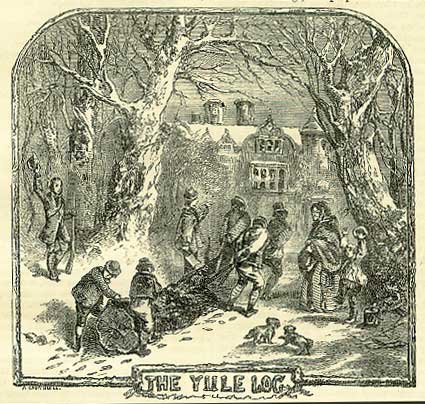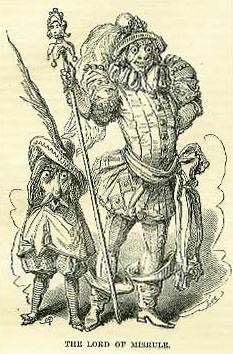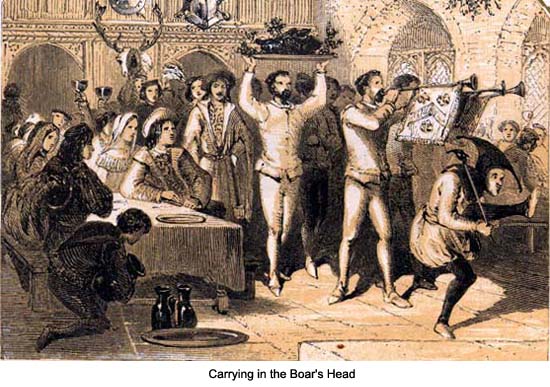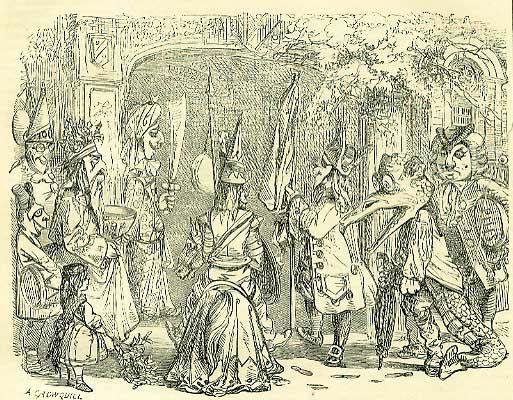A Medieval Christmas
by Jane Gilbert
When we think of medieval Christmas, our minds are filled with
images of royal banquets in halls bedecked with green, of
minstrels singing festive songs, noble lords and ladies gorging
themselves on roast goose. We imagine snow-topped hills, and
fresh bright mornings, where the differences between rich and
poor could be momentarily overlooked. Is it wrong to romanticize
like this? There is evidence to suggest that our imaginations
aren't far off the mark.
An Ancient Festival
The word 'Christes Maesse' surfaced in a Saxon book in 1038. But
the roots of this festival stretch back much earlier. In late
antiquity Christmas was not a time of revelry and fun, but
instead a time for a special mass, quiet prayer and reflection.
Until the fourth century, the church hadn't even fixed a date for
Christmas. Eventually, Pope Julius I chose December 25th. It
seems likely this was an attempt to christianize a pagan holiday
that fell on that date. Medieval folk were no strangers
to Christmas excitement. William the Conqueror was crowned King
of England in Westminster Abbey on Christmas day in 1066. This
was such a momentous occasion that the cheering inside the Abbey
made the guards outside think the king was being attacked. They
ran to his assistance and the coronation ended in a riot, with
people killed and houses burned.
But in Medieval times 25th December wasn't the most important
date: Epiphany was celebrated with more gusto. Some people say
that this day, 6th January or twelfth night, is to celebrate
Christ's baptism, others that Epiphany marked the visit of the
three kings bearing gifts to the baby Jesus. Some people forget
that Christ was born at Christmas, but they don't forget the gift
giving. While the kings may have brought gold, frankincense and
myrrh instead of Nike trainers and Playstations, the tradition
they started continues today.
 The medieval holiday of Christmas is an amalgamation of Christian
and pagan, old and new. In the pagan festival of Yule, druids
blessed and burned a log and kept it burning for twelve days as
part of the winter solstice. The church has its own version of
this -- Candlemas, or the Feast of the Purification of the Virgin
held on 2nd February. Medieval parishioners came to church with a
penny and a candle to be blessed. Other candles were taken away
to comfort the sick and dying or to give hope during
thunderstorms. The Yule log gave the pagans a symbolic light to
guide them through the harsh winter, while the Candlemas candle
gave Christians solace in times of cold and hunger. The joining
of these two traditions meant ordinary people could celebrate the
birth of Christ and their own salvation, as well as enjoy
themselves with the feasting and fun associated with pagan
tradition.
The medieval holiday of Christmas is an amalgamation of Christian
and pagan, old and new. In the pagan festival of Yule, druids
blessed and burned a log and kept it burning for twelve days as
part of the winter solstice. The church has its own version of
this -- Candlemas, or the Feast of the Purification of the Virgin
held on 2nd February. Medieval parishioners came to church with a
penny and a candle to be blessed. Other candles were taken away
to comfort the sick and dying or to give hope during
thunderstorms. The Yule log gave the pagans a symbolic light to
guide them through the harsh winter, while the Candlemas candle
gave Christians solace in times of cold and hunger. The joining
of these two traditions meant ordinary people could celebrate the
birth of Christ and their own salvation, as well as enjoy
themselves with the feasting and fun associated with pagan
tradition.
 But it wasn't fun for everyone. Childermass
or Holy Innocents Day was on December 28th -- the day King Herod
ordered the killing of all boys under the age of two in an
attempt to kill Jesus. While nowadays we might expect youngsters
to be playing with their new toys over the holiday season, in
medieval times they were cowering in cupboards. That's because in
medieval England, children were reminded of Herod's cruelty by
being beaten. Many thought December 28th a day of bad luck.
People were reluctant to get married on that day, or start
building something and Edward IV refused to be crowned. But it wasn't fun for everyone. Childermass
or Holy Innocents Day was on December 28th -- the day King Herod
ordered the killing of all boys under the age of two in an
attempt to kill Jesus. While nowadays we might expect youngsters
to be playing with their new toys over the holiday season, in
medieval times they were cowering in cupboards. That's because in
medieval England, children were reminded of Herod's cruelty by
being beaten. Many thought December 28th a day of bad luck.
People were reluctant to get married on that day, or start
building something and Edward IV refused to be crowned.
One example of the heady mix of Christian and pagan is the
tradition of the Lord of Misrule. This was someone appointed at
Christmas to be in charge of Christmas revelries, which often
included drunkenness and wild parties in the tradition of Yule.
Again, the church had an equivalent, called a boy bishop. This
tradition seems to come from ancient Rome, from the feast of
Saturnalia. During this time, the ordinary rules of life were
turned upside down. Masters served their slaves, and offices of
state were held by peasants. The Lord of Misrule presided over
all of this and had the power to command anyone to do
anything.
In the church, on January 1st's Feast of Fools, similar
strangeness occurred. Priests wore masks at mass, sang lewd songs
and ate sausages before the altar. It was a time of such wildness
that lords often employed special guards to protect their
property in case of rioting. Tenants of a manor belonging to
London's St Paul's Cathedral were obliged to keep watch over the
manor house, and were paid with a fire, a loaf of bread, a cooked
dish and a gallon of ale -- a sumptuous Christmas dinner.
Food for Thought
But what was medieval Christmas actually like? It was certainly
the longest holiday of the year, and brought with it cruelties as
well as privileges. Poorer people were let off work for the
festival, and sometimes were even treated to a Christmas dinner
in their landlord's great hall.
If you were lucky, that is. Some manors dished out Christmas
treats depending on status. One manor near Wells Cathedral in the
south of England invited two 13th-century peasants -- one a large
landholder and the other a small one. The first got a feast for
himself and two friends, including beer, beef and bacon, chicken
stew, cheese -- and even candles to light the feast with. The
poorer peasant did not fare so well. He had to bring his own cup
and plate. But at least he got to take home the leftovers, and he
was even given a loaf of bread to share with his neighbours. This
was used to play a traditional Christmas game. A bean was hidden
in the loaf and the person who found it became king of the feast.
This has turned into today's tradition of hiding pennies in
Christmas puddings to symbolize coming riches -- even if a penny
won't pay the dentistry bills for cracked teeth.
If you were higher on the social scale and were part of a
knight's household, or even the royal one, you would be treated
to a fabulous feast and gifts of jewels and robes. In 1482, the
famously generous King Edward IV gave a spectacular Christmas
gift to his people when he held a banquet that fed over two
thousand people each day. Even then the pressures to give at
Christmas were immense. Edward's brother, the notorious Richard
III had to sell items from the Royal household, and used items
from the treasury as pledges for loans in order to live up to his
brother's reputation. With the money he made, Richard presented
the city of London with a gold cup encrusted with jewels. He and
his wife Anne spent a staggering 1200 pounds on new clothes and
gifts for the court. He even licensed a merchant to bring jewels
into England -- as long as he had first choice so he could give
his wife impressive gifts.
But these weren't the only gifts given at Christmas. Famous
medieval chronicler Matthew Paris records that in 1249 King Henry
III got from London citizens 'the first gifts which the people
are accustomed superstitiously to call New Year's gifts.'
Portents of success for the coming year, these gifts are also
related to the modern tradition of 'first footing', where the
first person to set foot inside your house determined your
family's fortunes for the year.
On Boxing Day, rich lords often gave their tenants a small gift,
containing a moral lesson. The poor received money from their
masters in hollow clay pots with a slit in the top. You had to
break them to get the money out. Nicknamed 'piggies' these
offerings were the earliest version of a piggy bank, although it
is doubtful whether they encouraged much saving.
 If you were lucky enough to be present at a noble Christmas
banquet, you would have your fill of sumptuous starters and tasty
treats. Medieval noblemen often had a boar's head as their main
dish, served with rosemary and an apple or an orange in its
mouth. In the countryside it was traditional to kill a wild boar,
cutting off its head and offering it to the goddess of farming to
ensure a good crop in the coming year. But if boar was elusive,
you might have goose or venison. You might even be served with
swan, smothered in butter and saffron -- with the King's
permission, that is. (They are still royal property today.)
If you were lucky enough to be present at a noble Christmas
banquet, you would have your fill of sumptuous starters and tasty
treats. Medieval noblemen often had a boar's head as their main
dish, served with rosemary and an apple or an orange in its
mouth. In the countryside it was traditional to kill a wild boar,
cutting off its head and offering it to the goddess of farming to
ensure a good crop in the coming year. But if boar was elusive,
you might have goose or venison. You might even be served with
swan, smothered in butter and saffron -- with the King's
permission, that is. (They are still royal property today.)
Less fancy tables would have to make do with whatever was left.
Though not allowed to eat the best parts of the deer, a nobleman
full of Christmas spirit might allow his poor tenants to have the
leftovers. Known as 'umbles,' these parts were usually the heart,
liver, tongue, feet, ears and brains. They were made into a pie.
It's easy to see where our modern expression about having to 'eat
humble pie' comes from. However, if you weren't into deer
entrails, the church generously offered a fixed Christmas price
of 7 pence for a ready cooked goose -- although that was about a
day's wages.
Mince pies were also eaten at medieval tables. If you made a wish
with your first bite people said it would come true. But don't
refuse if someone offers you a pie, or you might suffer bad luck.
Another big treat of the medieval table was Christmas pudding.
Called 'frumenty' -- from the Latin for corn 'frumentum' -- it
was made of thick porridge, wheat, currants and dried fruit. If
available, eggs and spices like cinnamon and nutmeg were
added.
To wash down all this rich food there were two fine festive
tipples. Lambswool was a hot concoction of mulled beer with
apples bobbing on the surface. There was also Church Ale, a
strong brew reserved only for Christmas and sold in the
churchyard or even in the church itself.
Christmas Carousing
The proximity of alcohol to the church coincides with one or two
of the more lively Christmas traditions. Carols, such a staple
part of today's Christmas diet, were prohibited in many European
churches because they were considered lewd. They were often
accompanied by dancing. The leader of the carol dance sang a
verse of the carol, and a ring of dancers responded with the
chorus. However, carol dances were suggestive of the fertility
traditions of pagan song and dance cycles, and were thus
considered too coarse for church.
A famous Christmas song of today is The Twelve Days of
Christmas, where a list of presents given to the singer by
their 'true love' is recounted. The gifts range from 'eleven
lords a-leaping' to 'a partridge in a pear tree.' In medieval
times this was a game set to music. One person sang a stanza,
then another would add his own lines to the song after repeating
the first person's verse. One tradition says it was a catechism
memory song. It helped Catholics in post-restoration England
remember facts about their faith at a time when practising it
could get them killed.
Another popular form of Christmas entertainment was 'mumming'.
Similar to modern English pantomimes, these were unceremonious
plays without words which usually involved dressing up as a
member of the opposite sex and performing comic tales. They took
place throughout the twelve days of Christmas, and involved
members of the troupe parading the streets and visiting houses
for dancing and dicing.
 Of course, Christmas wouldn't be Christmas without festive
decoration. A description of twelfth century London says that
"every man's house, as also their parish churches, was decked
with holly, ivy, bay, and whatsoever the season of the year
afforded to be green." Whilst our gaudy modern decorations
would have confused a medieval person, they were still fond of a
bit of greenery to brighten up the murk of winter. Christians
believed that traditional Christmas plant, holly, had white
berries that turned red when Christ was made to wear the crown of
thorns. But holly was also important to the druids. So was
mistletoe, under which we still forge romantic encounters today.
Ivy, a plant associated with Bacchus, Roman god of wine and
carousing, was forbidden by the church because of its immorality.
(For more details, see The Holly
and the Ivy, by Julia Hickey.)
Of course, Christmas wouldn't be Christmas without festive
decoration. A description of twelfth century London says that
"every man's house, as also their parish churches, was decked
with holly, ivy, bay, and whatsoever the season of the year
afforded to be green." Whilst our gaudy modern decorations
would have confused a medieval person, they were still fond of a
bit of greenery to brighten up the murk of winter. Christians
believed that traditional Christmas plant, holly, had white
berries that turned red when Christ was made to wear the crown of
thorns. But holly was also important to the druids. So was
mistletoe, under which we still forge romantic encounters today.
Ivy, a plant associated with Bacchus, Roman god of wine and
carousing, was forbidden by the church because of its immorality.
(For more details, see The Holly
and the Ivy, by Julia Hickey.)
The story of Christmas trees also has long roots. The oak was
sacred to the druids and the Romans thought evergreens had
special powers. But for both pagans and Christians, the fact that
the fir tree kept its green needles throughout the ravages of
winter was enough for it to earn a place as a symbol of life and
renewal. This hope was vital whether you were celebrating the
birth of Christ or just desperately looking forward to the first
sign of spring. Even today we focus on them for Christmas
merriment.
Oliver Cromwell and his Puritan government tried to ban the
frivolities of Christmas and some of the more vernacular
traditions which developed during medieval times. But he didn't
succeed for long. Many of our modern traditions come from the
early mingling of the Christian and the pagan worlds. Whilst the
church secured Christmas as a truly religious Christian holiday,
peasants quietly continued with the old ways. The result is the
rich and eclectic mixture of old and new that characterizes
Christmas today. What better way to encapsulate the spirit of
Christmas than this fusion of different times, religions and
peoples to make a festival that has earned its place as one of
the favourites in our calendar.
Writer, teacher and psychologist, Jane
Gilbert comes from Devon, England, and lives by the sea in
Italy. After studying English Literature, she ran away to Brazil
where she travelled extensively and cuddled sloths. She likes
giraffes and curl reviver.
Article © 2005 Jane Gilbert
|
